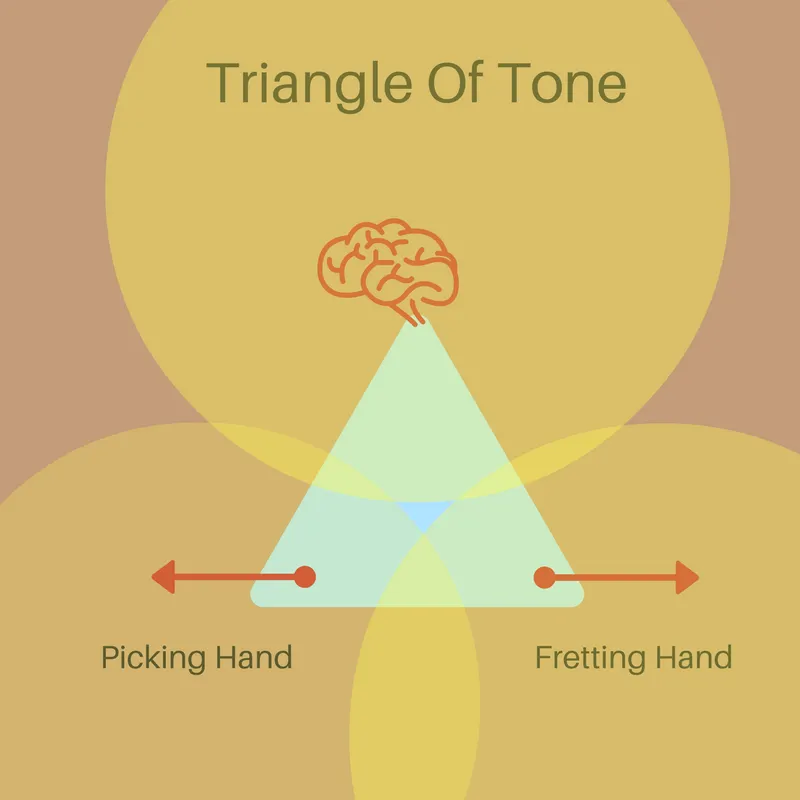Tone is that hard to define aspect of guitar playing that makes music sound pleasant to the ear and sit well with the listener. Creating good tone is a combination of numerous skills that take time to develop.
The good news, however, is that by practicing a few simple techniques you can achieve dramatic results quickly. Like the rest of guitar playing, you can also spend a lifetime perfecting your tone. Here are some things you can easily experiment with to find out what works for you. You might be surprised at the results.

Time for a tone diagnostic test…or, how good is your tone?
Listen to yourself make some UGLY sounds
Play some notes on your open D or G string. If you’re using a pick try changing the angle of attack to get some ugly sounds, Move close to the bridge, then away from it; all the while changing the way the pick strikes the string. Try stiffening up your picking arm so it is like a robot. Try lightly holding the pick, then gripping it tightly.
Now that you have succeeded in making some ugly sounds, try making some pleasant tones come out of the guitar. Tilt the pick downward and push it through the string, as opposed to pointing the pick upward and plucking the string. The difference in tone is remarkable.
Find the sweet spots
You can do the same thing with strumming; try to make the ugliest sound you can; make it nasty sounding. Now try to improve on it and keep trying different things similar to picking single notes until you recognize what makes for a better tone. Find that sweet spot over the sound hole where the tone is best. Now incorporate this into your playing until it becomes you!
If you use these tips you will improve your flatpicking guitar playing…period
How is your picking hand technique?
- Avoid planting your little finger on the top of the guitar. This is a common bad habit that limits your forearm movement, dampens the sound of the guitar and generally makes for an up-tight kind of sound. The idea is to allow your fingertips to float on the top of the guitar, not be firmly attached.
- Many instructional guides recommend planting the heel of your fretting hand on the bridge and playing from your wrist. This is also quite limiting for most people and causes a similar sort of up-tight sound. Some people do seem to manage this method, however. Dan Crary is a good example of this.
- Most people who have learned to strum well have a free, relaxed motion in their arm. Most of us tighten up too much when playing single notes and would do better to retain more of the free-floating motion of the strum. Relax, use your forearm and wrist together.
How is your fretting hand technique?
- Achieving good tone is a combination of your brain, your fretting hand and your picking hand. The idea is obviously to get all three doing what they should be doing in order to achieve the best musical tone.
- Listening is sometimes an uncommon trait. Listen to others play. Listen to recordings of players known to have good tone. Tony Rice, Russ Barenberg and Bryan Sutton are all great guitarists who have developed solid tone in their playing.
- Try to absorb that sound and imitate it in your playing. Of course it is not going to sound so good at first, but if you have a destination you are more likely to reach it than you will by wandering around.
- Your fretting fingers should be up next to the fret, not in the middle of the space between the frets. Experiment with the sound and it becomes obvious where the best tone is.
- You want to keep your finger on the note as long as possible in order to achieve sustain with the sound. Lifting your finger too quickly produces that choppy, staccato sound that is not at all musical. Let the notes ring, let the guitar sing out the notes, draw the sound out.
- You should play scales to develop this ability. Scales don’t have to be totally monotonous, make them sound musical, with sustain, legato (smooth, connected notes), and dynamics (change the volume of the notes as you play the scales).
Discography Of Bluegrass Guitar For Great Tone
Which fingering should you use?
When playing scales we are always told to use certain fingerings. This is a great idea, except that when actually playing tunes reality sometimes requires different fingering. That is just fine; it is the sound quality we are after, not technicalities of fingering!
That said, practicing scales with correct fingering trains the hands and mind to work together without thinking. Good habits are essential and violating a “rule†is not an excuse for laziness.
It reminds me of the time I read Einstein’s biography at the same time as a friend. Sometime later she made the comment that Einstein’s solutions just “came to himâ€, without having to work at it. Hold on a minute, I had just read how he labored for years doing experiments without finding a solution. Then, while playing his violin, the answer would come to him, “out of the blueâ€. Big difference!
Practicing scales
Ahhh, the dreaded scales. Practicing scales is a good thing for a lot of reasons, improving your tone is a major one.
- Strengthens your muscles
- Improves muscle memory
- Opens new fingering and voicing options for better tone
- Helps your body get settled and find the groove, or pocket of a song
- Makes sense of the mysterious fretboard
Some ways to make scales more interesting and effective are to play them musically, with and without a metronome, changing accents on the beat, playing them backwards, creating your own combination of scales, combining notes with chords, etc.
Ornamentations: hammer-ons, pull-offs, slides
Used properly, these ornamentations can accent a melody, smooth out a song, and embellish the ebb and flow of a tune. Not only that, but you can use them to free your fretting hand from so much work and give it time to move to the next position. Just don’t overdo it because too much of a good thing is, well, too much.
Timing
Finding the groove, or pocket of a song is essential for good tone. Fiddle tunes are almost always dance tunes and the guitar should have the effect of getting people to want to dance, or at least tap their toe!
I was struggling with the groove of Daley’s Reel one night and decided to try something different to get in the pocket. I noticed my wife was dancing around the room, which told me everything.Â
Try strumming the strings with your fretting hand dampening all of them to get the feel of the song. Then do the same thing with the root chord and just let yourself find that pocket and try to keep it as you play. You want the pulse, the rhythm, the groove, the pocket to carry the song.
If it is a fiddle tune you are playing, listen to how fiddlers play it. Usually there is a strong back beat and lilt to the melody that makes you want to get up and dance. Try to get that feel in your strumming and flatpicking.
Please leave a comment below and sign up for our free newsletter!

 Sign up to receive a free ebook: Master The Guitar in 7 days! (available for a limited period)
Sign up to receive a free ebook: Master The Guitar in 7 days! (available for a limited period)